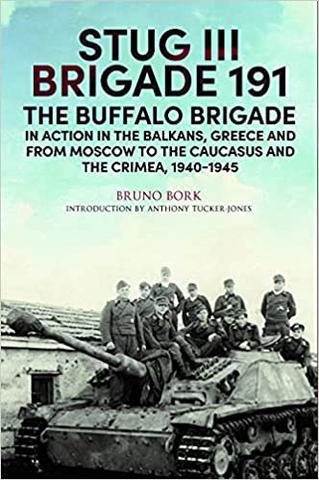StuG III Brigade 191 The Buffalo Brigade

StuG III Brigade 191 by Bruno Bork is a unit history, and a good one at that. Sometimes books like this can take the form of transcribed after-action reports. As such, they can be dry and uninteresting. Instead, this book provides rich insight into the German usage of assault guns during the Second World War, all while paying attention to the kind of details that other works may overlook.
Replete with photographs not likely to have been seen elsewhere, the book picks up with the formation of StuG Abteilung 191 and then tracks it's war-time deployments. Note that during most of the unit's history it is really an Abteilung and not a full brigade. Though the book's name and this account are intertwined with its primary weapon system, the Sturmgeschütz III, this is not a book that dwells on the technical details of the assault gun. Rather it's focus is on the events and people that used these assault guns as they fought across the Balkans, into the Soviet Union, and back through the Balkans again during the war's final year.
StuG Abteilung 191 has a rich combat history. It participated in some of the German Eastern Front's heaviest combat. That said, it does not overlook the unit's deployment in Greece during the spring of 1941, and does a great job illustrating the challenges faced therein. The majority of the book is focused on the unit's usage during Operation Barbarossa (in the Ukraine and then on the road to Moscow); during Operation Blue (at Voronezh, and in the Caucasus); and in 1943-1944 in the Kuban and Crimea. The account of Army Group A's 1942-1943 withdrawal from the Caucasus was much appreciated, as that operation is still a notably underlooked aspect of the war. The author interweaves interviews with military records to provide a number of interesting accounts highlighting the wide range of operations in which the unit engaged - including raids, recovery operations, mountain fighting, winter combat, breakthrough operations, and even dueling with off-shore Russian gun boats in the Crimea.
The book's primary value is in providing the reader with a better idea as to what it was like to participate in such combat operations. In addition, upon finishing this book the reader will doubtlessly better realize what a useful and versatile armored fighting vehicle the Sturmgeschütz III really was to the German armed forces. Considering its low-cost, effectiveness, and reliability one has to wonder what it might have meant to the German war effort had weapons like the StuG III been prioritized even more in their production over far more expensive and inefficient white elephants like the Tiger II.



Post new comment